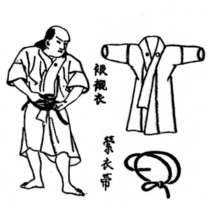Outside of Japan, a Shitagi (下着, lit. "under clothing") (also gusoku shita), a type of shirt worn by the Samurai class of feudal Japan when they were wearing full armour.[1]
The shitagi was the second garment to be put on, coming second only to the Fundoshi (Japan loincloth). The shitagi was like a short kimono with a button at the neck and a thin attached waist cord (obi).[2]
There are several different types of shitagi. The shitagi would be put on as though it were a kimono, the left hand being put first into its sleeve, and then the right, the neck would then buttoned and the waist cord finally tied at the back.[3]
In the common and modern use of Japanese language, however, "shitagi" just means an underwear.
References
- ^ Transactions and proceedings of the Japan Society, London, Volume 11, Author Japan Society of London, Publisher Kegan Paul, Trench, Trübner and Co., 1914 Original from Princeton University, Digitized Feb 25, 2008 P.136, P.137
- ^ Samurai armies, 1550-1615 Issue 86 of Men-at-arms series Volume 86 of Osprey military / Men-at-arms series Authors, Stephen R. Turnbull, Richard Hook Illustrated by Richard Hook, reprint Publisher Osprey Publishing, 1979 ISBN 9780850453027 P.24
- ^ Secrets of the samurai: a survey of the martial arts of feudal Japan, Authors Oscar Ratti, Adele Westbrook, Publisher Tuttle Publishing, 1991, ISBN 978-0-8048-1684-7 P.196
See also
- Keikogi
- Uwagi
